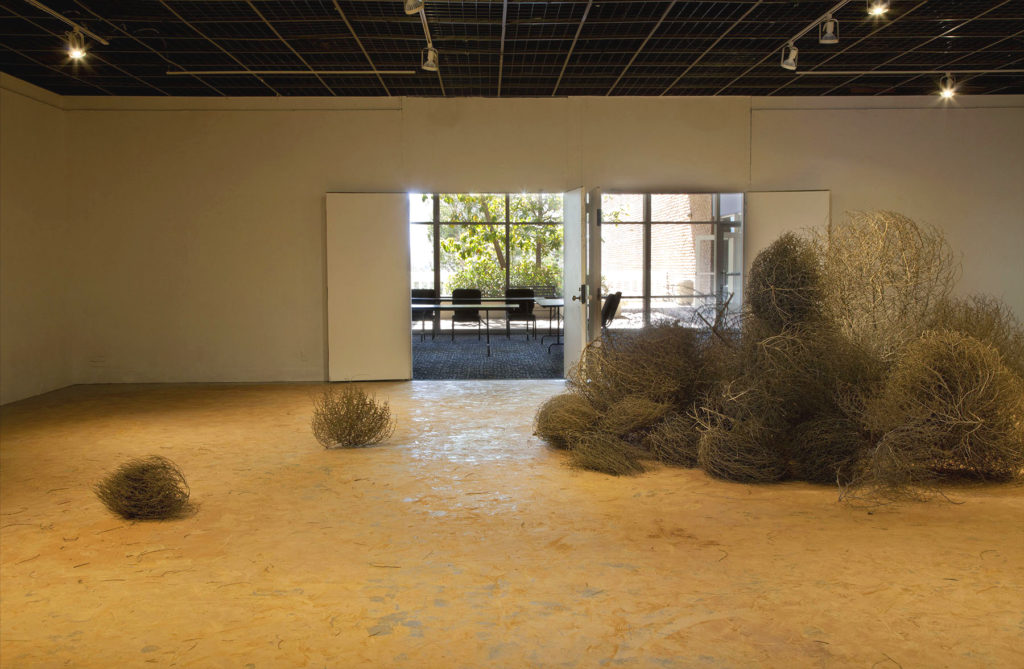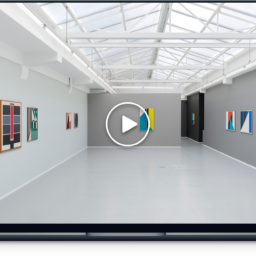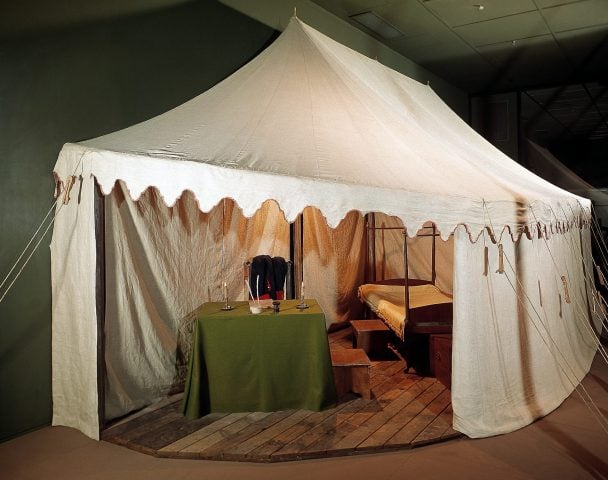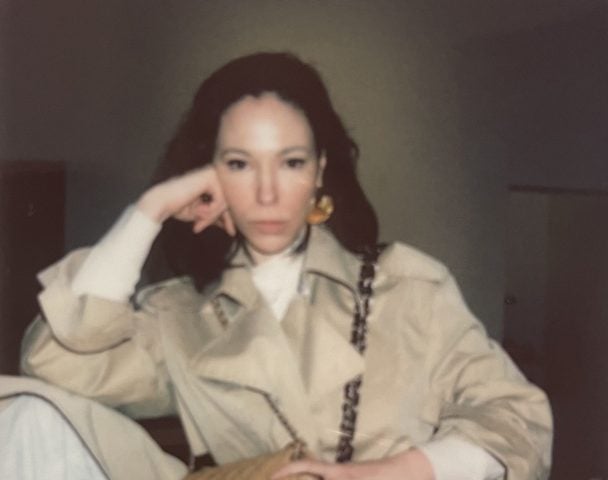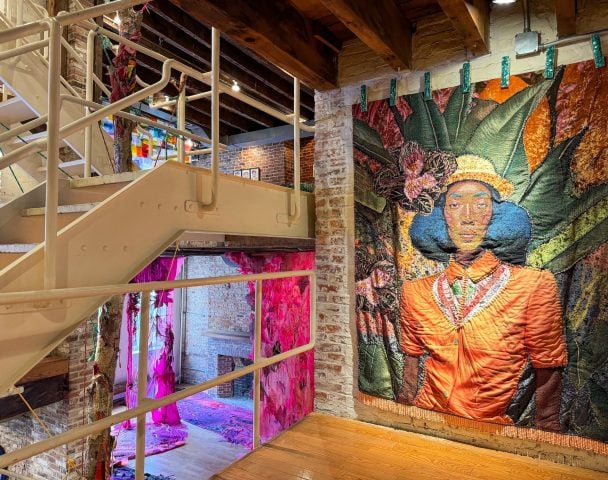On Wednesday night in New York, 30 art galleries stayed open late to accommodate visitors to the inaugural Chelsea Art Walk, a new initiative spearheaded by the Art Dealers Association of America. It’s a “great example” of how galleries are “finding ways to work together to encourage the public to visit their spaces,” says Andrew Schoelkopf, the association’s president.
If you read between the lines, it’s also a great example of how New York galleries are pushing vintage approaches to art viewership to fight plummeting foot traffic—a trend that’s threatening not only galleries’ commercial viability, but also their existential purpose as a free place to exhibit art. To people.
“I’ve seen attendance diminish a lot,” says Julie Saul, who has run a gallery in Chelsea for the past 18 years. “So about six weeks ago my gallery director said to me, ‘We gotta get some people in here.'” That’s when she called up the Art Dealers Association with the idea for the gallery walk. “I don’t think this art walk is going to change anything that significantly,” she says, but special occasions do seem to drive traffic more than mere exhibitions these days. And indeed, the art walk—which also included performances and talks—drew a turnout more typical of the September rush than the dog days of summer.
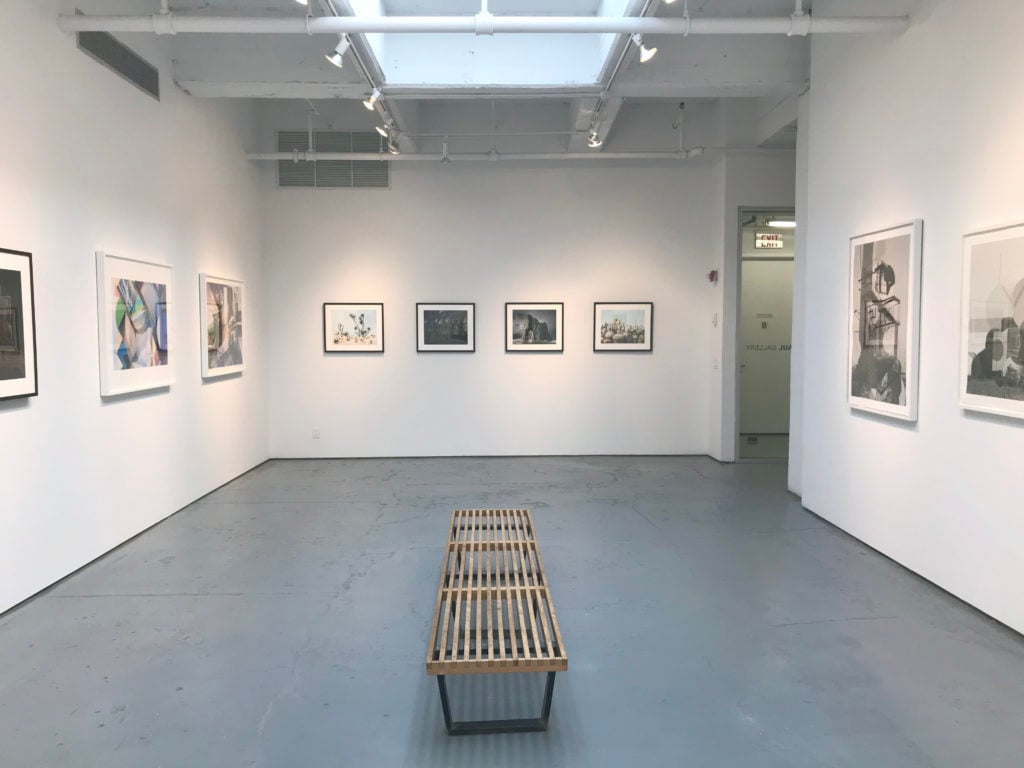
Installation view of the group show “DIY: Made In the Studio” at Julie Saul Gallery. Courtesy of the gallery.
Attendance on the Decline
“People are approaching art differently today. They’re not seeking out the thoughtful, complete statement that artists make when they create gallery exhibitions,” the dealer Wendy Brandow told the Los Angeles Times in 2012 to explain why she and her partner closed Margo Leavin Gallery after more than 40 years. “The exhibitions have been such an important part of what we do, and they are no longer valued as much by the public.”
Although commercial galleries don’t keep official visitor records, arts attendance on the whole has been on a long, well-documented decline. The number of Americans who visited art museums dropped from 40.8 percent in 1993 to 32.5 percent in 2012, according to a 2015 report from the National Endowment for the Arts.
Today, dealers say they no longer view physical galleries as the primary site of sales and networking. Instead, they name art fairs as the number one venue for meeting new clients, followed by the internet, according to TEFAF’s 2017 art market report. Nearly a third of dealers expect to do even fewer sales at galleries in the future, the report says—and they expect greater drops in this area than in any other, including private sales, auctions, online sales, and fairs.
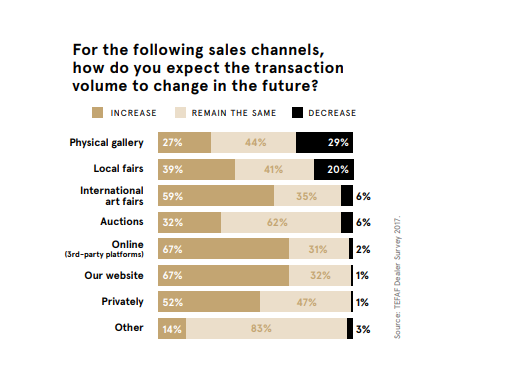
Thirty percent of David Zwirner’s sales today are made to buyers who see only emailed images, the dealer recently told the Wall Street Journal.
“The proliferation of ‘other options’ to encounter art is clearly the culprit,” says Magdalena Sawon, who owns Postmasters gallery. Brick-and-mortar spaces must now compete with “the vastness of visual data available online. Instagram, gallery websites, and selling platforms [that] are alternatives. So are art fairs.”
What’s at Stake?
Even though there are more places than ever to buy and look at art, many lament the educational and social resources the public stands to lose if galleries go under.
“I go around to galleries regularly and I hear everyone complaining that no one comes and looks at work and asks questions. No one wants to go to artists’ studios anymore,” says the art advisor and collector Thea Westreich. “Well, they’re missing all the fun: Looking at the work in person, particularly in a gallery when the dealer is present and available to talk with you about the work and why they’re showing it and how it fits in with their program and where it fits in historically.”
Gallery shows are also the primary instrument for artists to work through new ideas, market themselves, and receive critical feedback. “Gallery exhibitions are the most prolific stage for the creation and display of art. There would be very little contemporary art without brick-and-mortar galleries,” says dealer Stefania Bortolami. “It’s not just about the selling of art, it is about dialogue and an environment for creating culture.”
Like most downward trends in the art market today, small and mid-size galleries are the hardest hit by the drop in foot traffic. (The trailblazing Lower East Side gallerist Mitchell Algus told artnet News earlier this year that if three people walk through the door, he considers it a “good day.”)
Large galleries seem to be faring better. “We have not seen a decline in attendance,” says Hanna Schouwink, a senior partner at David Zwirner. In fact, the gallery saw a record number of visitors—a staggering 80,000—to its Yayoi Kusama exhibition in Chelsea last year. “Our clients and our general audience want to see our exhibitions and they want to see art works in person. However, we have noticed that more of our New York clients visit during the week for focused visits, rather than everyone stopping by on a Saturday afternoon, as was the norm for many years,” Schouwink says.
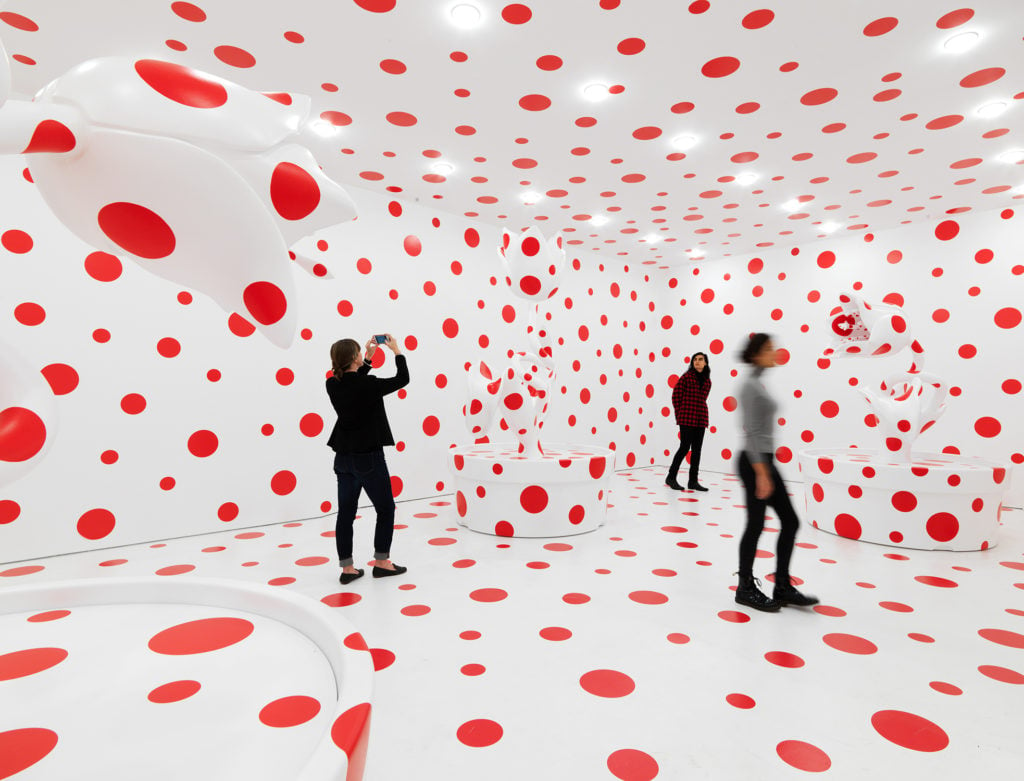
Installation view of “Yayoi Kusama: Festival of Life” at David Zwirner (2017). Image © Yayoi Kusama. Courtesy of David Zwirner, New York; Ota Fine Arts,Tokyo/Singapore/Shanghai; Victoria Miro, London; YAYOI KUSAMA Inc.
The New York-based artist Sean Scully says he’s noticed a growing chasm between the scene at the “uber galleries,” as he calls them, and comparatively “quiet” mom-and-pop shops in recent years. “If you look at individual shops everywhere, like newspapers, they seem to be dying out, and this might be happening in the art world too, which is a crying shame.”
Scully’s own gallery, Cheim and Read, shocked art insiders last month when it announced it would close its Chelsea space after 21 years and transition into private practice—a move that Scully attributes to the rise of mega-galleries like David Zwirner, which recently poached the Joan Mitchell Foundation from Cheim and Read. Now, Scully is going to the London- and Berlin-based blue-chip gallery Blain Southern, which he says is opening a space in New York in the coming months. (A representative for the gallery declined to confirm the expansion.)
What’s Next?
So what’s a small, unter-gallery to do? There’s a double bind in the current state of the market: Art fairs introduce risk and added expenses to the already costly overhead of running a New York gallery, yet many of the top events require dealers to maintain physical spaces in order to participate.
Meanwhile, online-only art intermediaries are increasingly looking to open physical galleries—a hybrid “bricks-and-clicks” model, like Amazon’s, that some predict will be the future of art sales. “If, or when, a gallery’s fair and inventory offerings are fully integrated into easily accessible and searchable databases, how much easier would it be for a potential art buyer to arrange to see a work of interest at an art fair near them or find a gallery close enough that has exactly the right piece?” the 2017 TEFAF report’s authors asked.
Still, others anticipate more collaboration between galleries and fairs to keep both afloat. “I envision strategic overlap becoming much more sophisticated, whereby gallery exhibitions are coordinated with art fair presentations more and more to where the strongest potential within both (critical acclaim in the space and sales at the fair) is nearly scientifically calibrated,” the dealer Ed Winkleman once wrote on his blog.
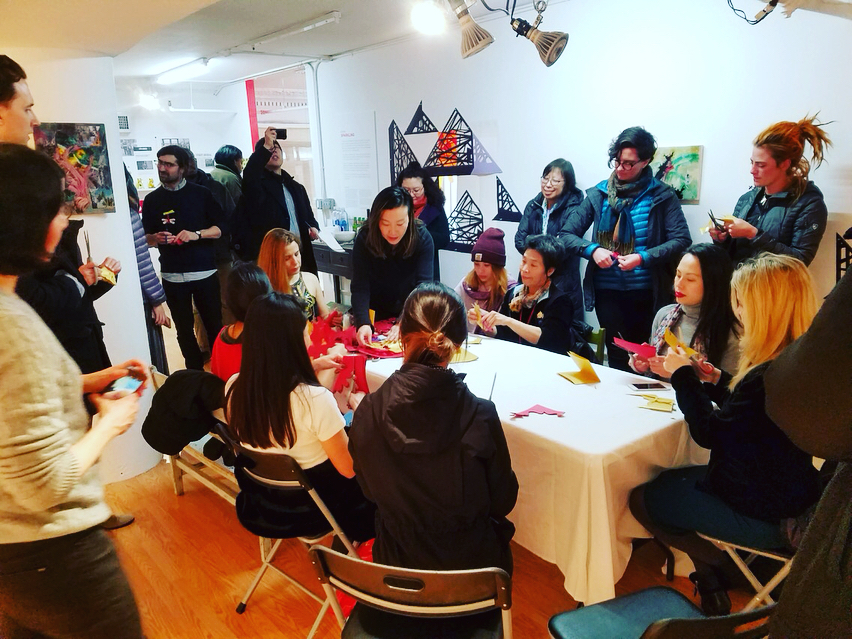
A post from @pearl_river_mart during Tribeca Art and Culture Night. Image via Instagram.
Or perhaps it’s all part of a natural cyclical change that will recalibrate itself. After all, the debate over the necessity of seeing works of art in person (or not) isn’t new to the 21st century. “This notion of being able to look at art in JPG or online goes back to the mid-1980s, when they were sending out these giant eight-by-ten transparencies,” Westreich says. “But my guess is that really great collectors will still insist on being in the room.”
In the meantime, we may see more throwbacks like this week’s Chelsea Art Walk or the quarterly Tribeca Art and Culture Night, which Sawon says has been “very successful” in bringing foot traffic to Postmasters.
One inducement for in-person viewing that didn’t exist decades ago, however, is the potential to share the experience online later. “Join us tonight for the #ADAA Chelsea Gallery Walk,” tweeted Pace/MacGill Gallery ahead of Wednesday’s event. But don’t forget, it added, to “share your visit on #instagram.”
Follow Artnet News on Facebook:
Want to stay ahead of the art world? Subscribe to our newsletter to get the breaking news, eye-opening interviews, and incisive critical takes that drive the conversation forward.
